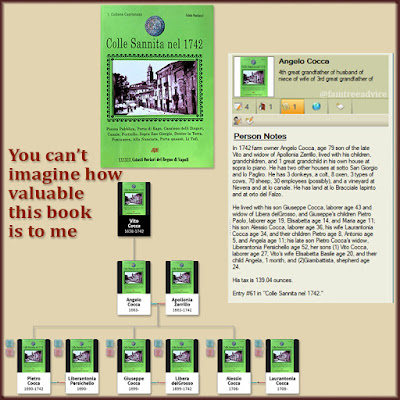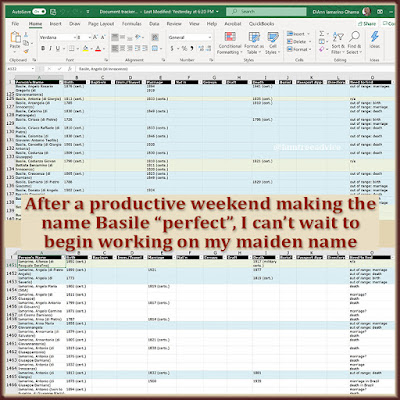I love when people tell me they aren't Italian, but my advice helps with their genealogy research. I try to keep my articles generic. But since I'm all Italian, I have to use Italian examples as illustration.
I've avoided writing about my new favorite genealogy treasure. It makes my heart swell every time I use it. But it's so specific. Not only to Italian ancestry, but to my grandfather's hometown. (Oh boy, here she goes again with Colle Sannita.)
Indulge me, though, because you will wish you had one of these for your ancestral hometown. And some of you may. At the bottom of this article are 46 Italian towns with a similar book.
Years ago a man found my post on an Italian message board devoted to my grandfather's hometown. That man, Dr. Fabio Paolucci, came from Grandpa's town, and is a local historian. He told me my maiden name of Iamarino is one of the original names from the town of Colle Sannita. Sometime later, he gave me my paternal family tree, dating back to the year 1690.
At that time, Italian vital records were not online. And Italian church records (from my area) are still not online. So Fabio provided me with something that was impossible for me to get on my own.
He pored over the oldest records from the town, piecing together hundreds of families. I knew he was writing a book, but I didn't know what it would contain. Until I finally got my hands on "Colle Sannita nel 1742" (nel means in).
Like a census, Italian towns produced a register (catasto) of every person in their town. This register lists the assets owned by the head of household. From individual plots of land to the number of sheep and mules. Based on their assets, the town calculated each household's tax.
This register also lists the names, ages, and occupations of each member of the household. In the book, I have the names, ages, and assets of each family living in my grandfather's hometown in the year 1742!
 |
| This detailed description of each household in my ancestral hometown is the best genealogy tool ever! |
My family tree already contained a good number of people born in the 1700s. But this book is helping me form their families and nail down each person's year of birth. That's invaluable! I'm also getting a better idea of life in these early years. Many of the households owned several plots of land, including many vineyards. Most families owned their own home. Several households included a man and his immediate family, his widowed mother, and his siblings and their families.
There were 560 households in town in 1742. I'm up to #343, looking for each family in my tree. If I find a match:
- I add the names, ages, and occupations of each member of the family.
- I give each fact a source I created for the book, including a photo of the book cover.
- I make the book cover the profile photo for each person, unless they already have a document as their photo. In that case, I add the book cover to their collection of images.
This makes it easy to track everyone I found in the book. In Family Tree Maker, I can view the image and see that I've identified 406 people from the book so far.
This past weekend I followed my own advice to make one thing perfect in my family tree. I worked my way through everyone in my tree with the last name Basile (bah-ZEEL). I found each person's available vital records within my collection of the town's records.
Then I turned to my new favorite book and found 13 people named Basile to document in my family tree. (There are more, but I can't fit them into my tree yet.)
It was such a rewarding weekend. I chose Basile because it was the first Colle Sannita name early in the alphabet that came to mind. Halfway through I thought, "why didn't I start with my maiden name?" So that's what I'll do next. I'll find all the available vital records for everyone name Iamarino in my family tree. And I'll use the Colle Sannita book to find even more details about those alive in 1742.
 |
| I worked through everyone in my family tree with one name, and completed their records and source citations. |
If you do have Italian ancestry, check the list below for your towns. I found these by searching for "catasti" on the publisher's website. I bought my book online using PayPal, and they shipped it quickly. The books sell for 30 Euro, but with shipping, it was more than $60. Still, the best money I ever spent.
Town registers available from the same publishing company are:
|
Acerra Aiello Casale di Atripalda Altavilla Apice (I need that one!) Atripalda Avellino Bonito Caggiano Calabritto Carovigno Caserta Castelpagano Castelvolturno Cervinara Colle Sannita Conza |
Foiano Gesualdo Guardia Itri Lapio Lentace Marzano Massa Lubrense Monteforte Montefusco Montemiletto Monteverde Mugnano Nereto Pellezzano (part of Salerno) |
Pertosa (part of Caggiano) Pietrastornina Ponte Cagnano Faiano Praiano Prata Sannita Ravello Quaglietta San Cipriano San Giorgio della Montagna San Pietro di Scafati Santa Maria Capua Scafati Tavernola Casale d'Atripalda Torrioni Vico Equense |
These books are a dream come true for someone like me, with deep roots in one or more of these towns.
If only Neirone, Genova was one of the books!
ReplyDeleteThey seems to be mostly southern towns, don't they? Hold onto the publisher's link and check again once in a while. I have to evaluate my branch from Apice and decide if that book will be useful to me.
DeleteHello DiAnn,
ReplyDeleteYou do such a great job on your Blog. I enjoy reading it every Tues & Friday, an my Ancestry is mostly Scottish, English and German! Do you know of any Blogs specifically for those countries? Don't worry I am still going to enjoy your Blog. I still look forward to each post.
Carey Alexander Roos
Thanks, Carey! I have Roos friends in New Hampshire. I mostly avoid other blogs so I'm not even subliminally influenced by them. But Twitter has a fantastic genealogy community, and many are Scottish. Try starting with a #ScottishGenealogy search. https://twitter.com/search?q=%23scottishgenealogy&src=typed_query
DeleteFollow up with https://twitter.com/search?q=%23englishgenealogy&src=typed_query and https://twitter.com/search?q=%23germangenealogy&src=typed_query
ReplyDeleteDo you still verify what you find in the book, when documents become available for all to see? I had a booklet from a researcher about my little ancestral village in Alsace. Now that the documents are finally available on line, I can find many errors. Probably "happy fingers" when taking notes to prepare the booklet at the time. But I am glad I am going back to verify. I too wish the little towns around Bergamo would have something that goes before 1860. There are also no documents there from the era of Napoleon. Annick H.
ReplyDeleteIn this case, I trust Fabio Paolucci implicitly. If these documents are ever made available, I'll be thrilled to add the images to my family, and I can check them then. But that may never happen. I have found a couple of errors in the index, but that could be due to a change in the galleys late in the process.
DeleteWow what an incredible resource. I am going to search to see if there are an Sicilian resources like this. Incredible find.
ReplyDeleteRo
Hi DiAnn,
ReplyDeleteMy PGG was born in Italy but I can't find out where! Do you as a Reseacher have a place or suggestion as to I should be looking? I don't even have Names of his Parents which naturally be helpful!! Not even listed in censuses.
Are the books you have listed is it written in Italain?
Thanks in advance,
Maria C.
Hi, Maria. Often the best source of your ancestor's hometown is a ship manifest when they emigrated. But if they arrived before the late 1890s, the manifest won't include their town. You can also enter his last name into the Cognome box at https://www.cognomix.it/mappe-dei-cognomi-italiani to see where that name is found in Italy. If you get lucky, the name may be specific to only a few towns. It's also possible to find a hometown on naturalization papers, passport applications, and draft registration cards (I made a big discovery on a WW2 card).
DeleteIt's possible his parents names were the same as his eldest son and daughter, since that's the Italian tradition. That holds true for me in much of my family. My parents seem to be the only ones who didn't know the rules.
Yes, the books are in Italian. The family listings are not difficult to understand, with the help of Google Translate. I picked out a few interesting facts from the other sections of the book, but I know there is more in there than I need to translate.
Thank you for this wonderful resource! I have ordered one and plan to get another for my ancestors from that town.
ReplyDeleteThat's great! Which town is yours? I'll bet the publisher will be surprised by the sudden interest.
Delete